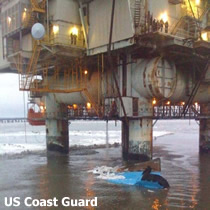
 |
|
|
August 15, 2009 Monarch fuel removal operations successfully completed in Cook InletA US Coast Guard press release:Following the successful removal of all recoverable fuel from the motor vessel Monarch in early August, the unified command has released equipment and personnel from the operations Monday. 
It is estimated that nearly 12,445 gallons of diesel fuel were recovered by divers using hoses and vacuum wands to pump fuel oil from the Monarch into temporary storage tanks on board the Polar Bear. Earlier estimates of fuel remaining on board the Monarch were adjusted in early August when divers discovered additional damage to fuel tanks thought to still hold fuel. A final amount of fuel recovered will be determined once temporary fuel storage tanks on the Polar Bear are emptied in the next week. The Monarch, a 166-foot offshore supply vessel, has been submerged at the base of the Granite Point oil platform in northern Cook Inlet since it collided with the platform in heavy ice on Jan.15, 2009. At the time of the sinking, an estimated 34,603 gallons of diesel fuel and lube oil were on board the vessel. A light sheen was seen in the area on the day of the sinking. Heavy ice in Cook Inlet during the late winter prevented any immediate fuel removal operations. "Fuels remaining onboard presented an ongoing threat to Alaska's environment; we are pleased that all the tanks on the vessel have been checked," said Steve Russell, Alaska Dept. of Environmental Conservation's deputy-state on scene coordinator. "Pollution prevention and response will continue to play a key role in any operations regarding final disposition of the vessel." Coast Guard and Alaska Dept. of Environmental Conservation representatives began working in a unified command with the vessel's owner, Ocean Marine Services, Inc. (OMSI), immediately following the sinking. The group approved a plan to monitor the vessel's position and stability using sonar imaging from another vessel and the Granite Point platform throughout the winter until conditions were safe for divers to access the vessel. Joey Willis, OMSI vice president and incident commander for the fuel removal operations said he was pleased with the overall success of the operation. "We hired some of the best to help with this difficult project," said Willis. "Global Diving and Salvage along with Capt. David Stirling of Stirling Salvage have done an excellent job of developing and implementing the fuel removal operations safely under very challenging circumstances." Global Diving and Stirling Salvage completed an initial vessel damage assessment in May and proposed options for the removal of fuel to the unified command. Successful fuel removal operations commenced in July utilizing the landing craft Polar Bear as a dive platform with a mooring system that included two 12,000 pound anchors and more than 4,000 feet of one and a half inch wire cable. Global divers dove three times per day completing 34 dives during the fuel removal operations aboard the Monarch which rests just south of the platform in an up-side down orientation. Representatives from the Coast Guard and Alaska Dept. of Environmental Conservation monitored operations through a site visit and received regular reports from the field. "Safety is always in the forefront when planning and conducting these types of operations" said Capt. John Kenyon, federal on-scene coordinator for the Coast Guard. "We are all very pleased that there were no accidents or injuries despite the complexities of the dive operations in Cook Inlet." OMSI is preparing a post-fuel removal report to submit to the oversight agencies. They will also continue to work with Chevron to identify the safest options for final action with regard to the vessel. Once the best course of action is identified, OMSI will submit a final recommendation for vessel disposition to the appropriate agencies for review and approval. © AlaskaReport.com All Rights Reserved. |
|